Online Retailing – A Business Model Typology
By Prof. Dr. Silvia Zaharia and Marc Janssen
Retailing is as old as mankind. The Agora of Athens dates back to the 4th century B.C. and is one of the first known commercial marketplaces. In an evolutionary way many retailing concepts have developed and vanished during the centuries. But with the advent of the Internet, the pace of innovation in retailing has accelerated radically. In a Darwinist fashion retailing concepts come and go within years instead of decades or centuries. In this article we discuss the main business models as we currently see them in online retailing.
While “retailing” historically refers to the part of the value chain that takes care of selling goods or services directly to consumers or end-users, the boundaries between retailing, wholesaling and manufacturing are blurring because of the Internet. Essentially, modern retailing is about getting products or services from the producer to the end-user. The overview below depicts the dominant high-level business models we can distinguish.

1. Direct-to-Consumer Selling
Nowadays enabled by the Internet, Direct-to-Consumer (also: D2C) is the purest and most direct form of getting products or services from the producer to the end-user. The obvious big advantage is that the Gross Margin does not have to be shared with other parties in the supply chain. The challenge for these sellers is that they, in addition to the design and production of the product or service, are responsible for all supply chain tasks:
- Warehousing & Logistics
- Ownership & Risking
- Promotion
- Financing
- After-sales service
- Customer transaction & payment 1)
Any other party that aims to play a role in this process, be it retailers, wholesalers, marketplaces or whatever, will need to prove that they can enhance the customer experience and/or increase the supply chain efficiency in one of the above area’s.
2. Marketplace Direct-to-Consumer Selling
Direct-to-Consumer Selling via Marketplaces is similar to the regular D2C sales concept. The main difference is that the products are marketed through marketplaces, such as Amazon, Bol.com or Kaufland. Compared to the regular D2C approach the seller outsources a substantial part of the supply chain tasks to the Marketplace, in particular:
- Promotion
- Customer transaction & payment
- Possibly: Warehousing & Logistics (e.g. Fulfilment by Amazon)
By doing so the seller can achieve a stronger focus on the product design / production / logistics part of the business and it might gain more efficiency in the distribution part of its business compared to a regular D2C approach. The usage of marketplaces makes these business models extremely scalable. It is fairly easy to roll-out products across multiple marketplaces, nationally or internationally. Companies like Thrasio, Berlin Brands Group, SellerX or Dwarfs use this to their advantage by acquiring small e-commerce players and help them to realise this type of scaling.
3. Reselling
The Online Reseller sources from multiple producers/brands, possibly via a wholesaler. These products or services are typically aggregated into a consistent assortment that is marketed to end-users via an own branded web shop.
The Online Reseller will cover the entire set of supply chain tasks that need to be performed, but with a very strong customer-centric focus. Within the promotional activities the reseller will typically aim to add value by means of “inspiring” the consumer and by combining assortments from different producers into an enhanced offering.
4. Marketplace reselling
The Marketplace Reseller also sources products from producers/brands, but markets these via marketplaces. Because of the chosen marketing channel, the commercial need to aggregate products into a consistent assortment is less than for Online Resellers. The criteria to take products into the assortment are often more driven by the operational efficiency that can be achieved. The Marketplace Reseller outsources supply chain tasks to the Marketplace, in particular:
- Promotion
- Customer transaction & payment
- Possibly: Warehousing & Logistics (e.g. Fulfilment by Amazon)
Compared to the Marketplace D2C Seller, the Marketplace Reseller is disadvantaged as they have to source products from producers and will therefore have lower gross margins. This disadvantage will typically be compensated by taking more products into the assortment and increase the economies of scale.
5. Omni-Channel reselling
Omni-Channel Resellers aim to enhance the customer experience by combining the strengths of physical and online retailing channels. The Omni-Channel reseller will cover the entire set of supply chain tasks that need to be performed with a very strong customer-centric focus. At multiple touch-points in the customer journey the customer has the option to interact with online or physical channels of the reseller. By doing so the Omni-Channel reseller is in a unique position to offer specific convenience services across online and physical channels that enhance the customer experience and the retailer brand experience. Examples of such services: Click&Collect, Return-to-Store or Ship-from-Store.
6. Omni-Channel Direct-to-Consumer
The combined strength of a D2C positioning with an Omni-Channel distribution structure can be extremely powerful. The producer/brand is in full control of the product as well as the distribution channel. These companies are therefore perfectly positioned to optimise the customer experience at an attractive cost price positioning. An example would be Apple who sell directly via the internet as well as via their physical Apple Stores. Tesla has adopted a similar position.
Marketplaces
In the above typology ‘Marketplace’ is not listed as a separate business model. The reason for this is that – in its pure form – the marketplace is ultimately not responsible for the operational transaction with the end-user. The marketplace merely facilitates a transaction between seller and customer, and for this facilitation they receive a fee. Operating a marketplace should therefore be classified as a marketing service, rather than a retailing concept. In this view Amazon and Bol.com operate 2 business models in parallel. On one hand they are an Online Reseller for the products they sell themselves as a webshop, and on the other hand they offer a marketing service by granting other retailers access to their traffic and facilitating transactions on behalf of them.
Examples
Similar to Amazon and Bol.com not all online retailers have adopted a single, pure business model as described above. For instance, many Online Resellers are also Marketplace Resellers and many D2C companies sell via marketplace as well as their own shop. Often with the same products, they operate two or more business models in parallel, each with its own set of KPIs, profitability levels and business dynamics.
The overview below lists some typical examples of online retailers and how they operate pure or combined business models as we discussed above.

As mentioned in the introduction, new business models come and go rather quickly in this turbulent phase in internet-based retailing. In this article we classified the most dominant ones, but others do exist in niche markets. Some examples: Drop-Shipment Reselling, Influencer D2C Brands or Social Media Reselling. But these have yet to prove that they are substantial enough in volume and sustainable enough over time to be considered dominant business models in online retailing.
Impact on Data Science
In a digital world, “data” is a highly strategic asset. This is especially true for customer-related data. The business model that a company has adopted determines the quality and value of the data it collects. And this data structure determines the opportunities and challenges the company has when using data to its advantage. Therefore, a companies’ business model and objectives should be the starting point of any data science activity.
As Neural Search Labs we specialise in using data science for retailers that need to advertise across marketplaces and platforms. Understanding our customer’s business is the starting point of everything. And while every business is unique, the typology described in this article has proven very useful in quickly identifying specific challenges and opportunities.
1) Based on: Marketing Channel Strategy, 9th Edition, Robert W. Palmatier, Eugene Sivadas, Louis W. Stern, Adel I. El-Ansary, Routledge 2019.




Leave A Comment
You must be logged in to post a comment.